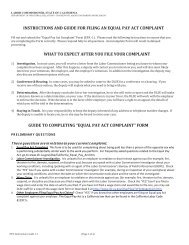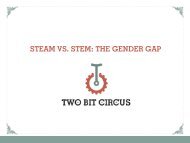EQUITY
2eGXKK2
2eGXKK2
You also want an ePaper? Increase the reach of your titles
YUMPU automatically turns print PDFs into web optimized ePapers that Google loves.
1<br />
WOMEN<br />
AS AN UNDERUTILIZED<br />
RESOURCE TO ADDRESS<br />
MIDDLE-SKILL JOB<br />
SHORTAGES<br />
Introduction<br />
Many middle-skill jobs—those jobs that<br />
require more than a high school diploma<br />
but less than a bachelor’s degree—offer<br />
the potential of employment with familysustaining<br />
earnings. Well over a third of all<br />
workers (37.2 percent) are employed in these<br />
occupations, and over a third (34.4 percent)<br />
of all projected job openings are in middleskill<br />
occupations. 1 While not all middle-skill<br />
occupations offer family-sustaining wages,<br />
the majority of projected job openings (55<br />
percent) are in occupations with median<br />
annual earnings of at least $35,000, 2 and<br />
may be stepping stones to higher paid<br />
careers. Many employers report difficulty<br />
finding workers to fill vacancies in middleskill<br />
occupations, including in the key<br />
growth sectors of advanced manufacturing;<br />
transportation, distribution, and logistics;<br />
1 IWPR analysis based on IWPR O*Net database and 2014-<br />
2024 BLS projections (see Appendix A) of total job openings<br />
(resulting from job growth and employee turnover). In<br />
2014, 53.8 million workers were employed in middle-skill<br />
occupations, 37 percent of all workers.<br />
2 IWPR analysis based on IWPR O*Net database (see<br />
Appendix A) and 2014-2024 BLS projections of total job<br />
openings in middle-skill occupations, excluding openings<br />
in occupations projected to decline.<br />
and information technology (Accenture et al<br />
2014; National Skills Coalition 2014).<br />
Women are only 29 percent of workers in growing<br />
middle-skill IT occupations, and they are fewer<br />
than 10 percent of workers in growing advanced<br />
manufacturing or transportation, distribution,<br />
and logistics occupations.<br />
Women need better access to middle-skill<br />
jobs with family-sustaining wages. Women<br />
serve as the primary or co-breadwinner in<br />
half of U.S. families (Hess et al 2015). As the<br />
economy has recovered, millions of workers<br />
found jobs, but many of these new jobs pay<br />
too little to lift a family out of poverty. Women<br />
are the majority of full-time workers whose<br />
earnings leave them in near poverty. 3 One in<br />
four Hispanic women (24.2 percent) and close<br />
to one in five Black women (18.1 percent)<br />
work full-time and earn less than $400 per<br />
week (U.S. Department of Labor unpublished).<br />
3 Near-poverty is defined as 200 percent or less of the federal<br />
poverty threshold; the threshold varies by family type. In<br />
2014, the near-poverty threshold for one adult with one child<br />
was $32,634 or $627.58 per week. The near poverty threshold<br />
for an adult with two children was $733.58 per week, or<br />
annual income of $38,146 (U.S. Census Bureau 2015).<br />
WWW.WOMENANDGOODJOBS.ORG PATHWAYS TO <strong>EQUITY</strong> 1




